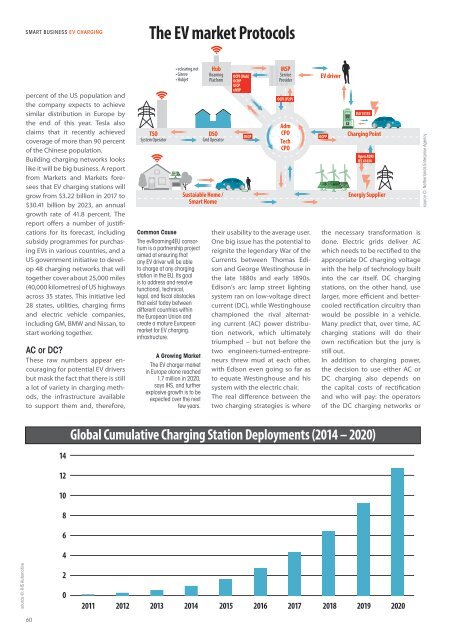Smart Industry No.1 2022
Smart Industry No.1 2022 - The IoT Business Magazine - powered by Avnet Silica
Smart Industry No.1 2022 - The IoT Business Magazine - powered by Avnet Silica
You also want an ePaper? Increase the reach of your titles
YUMPU automatically turns print PDFs into web optimized ePapers that Google loves.
<strong>Smart</strong> Business EV Charging<br />
The EV market Protocols<br />
percent of the US population and<br />
the company expects to achieve<br />
similar distribution in Europe by<br />
the end of this year. Tesla also<br />
claims that it recently achieved<br />
coverage of more than 90 percent<br />
of the Chinese population.<br />
Building charging networks looks<br />
like it will be big business. A report<br />
from Markets and Markets foresees<br />
that EV charging stations will<br />
grow from $3.22 billion in 2017 to<br />
$30.41 billion by 2023, an annual<br />
growth rate of 41.8 percent. The<br />
report offers a number of justifications<br />
for its forecast, including<br />
subsidy programmes for purchasing<br />
EVs in various countries, and a<br />
US government initiative to develop<br />
48 charging networks that will<br />
together cover about 25,000 miles<br />
(40,000 kilometres) of US highways<br />
across 35 states. This initiative led<br />
28 states, utilities, charging firms<br />
and electric vehicle companies,<br />
including GM, BMW and Nissan, to<br />
start working together.<br />
AC or DC?<br />
These raw numbers appear encouraging<br />
for potential EV drivers<br />
but mask the fact that there is still<br />
a lot of variety in charging methods,<br />
the infrastructure available<br />
to support them and, therefore,<br />
TSO<br />
System Operator<br />
• eclearing.net<br />
• Gireve<br />
• Hubjet<br />
Common Cause<br />
The evRoaming4EU consortium<br />
is a partnership project<br />
aimed at ensuring that<br />
any EV driver will be able<br />
to charge at any charging<br />
station in the EU. Its goal<br />
is to address and resolve<br />
functional, technical,<br />
legal, and fiscal obstacles<br />
that exist today between<br />
different countries within<br />
the European Union and<br />
create a mature European<br />
market for EV charging.<br />
infrastructure.<br />
Hub<br />
Roaming<br />
Platform<br />
DSO<br />
Grid Operator<br />
Sustaiable Home /<br />
<strong>Smart</strong> Home<br />
A Growing Market<br />
The EV charger market<br />
in Europe alone reached<br />
1.7 million in 2020,<br />
says IHS, and further<br />
explosive growth is to be<br />
expected over the next<br />
few years.<br />
OCPI (Hub)<br />
OCHP<br />
OICP<br />
eMIP<br />
OSCP<br />
MSP<br />
Service<br />
Provider<br />
OCPI (P2P)<br />
Adm<br />
CPO<br />
Tech<br />
CPO<br />
their usability to the average user.<br />
One big issue has the potential to<br />
reignite the legendary War of the<br />
Currents between Thomas Edison<br />
and George Westinghouse in<br />
the late 1880s and early 1890s.<br />
Edison’s arc lamp street lighting<br />
system ran on low-voltage direct<br />
current (DC), while Westinghouse<br />
championed the rival alternating<br />
current (AC) power distribution<br />
network, which ultimately<br />
triumphed – but not before the<br />
two engineers-turned-entrepreneurs<br />
threw mud at each other,<br />
with Edison even going so far as<br />
to equate Westinghouse and his<br />
system with the electric chair.<br />
The real difference between the<br />
two charging strategies is where<br />
EV driver<br />
OCPP<br />
ISO 15118<br />
Charging Point<br />
Open ADR/<br />
IEC 61850<br />
Energiy Supplier<br />
the necessary transformation is<br />
done. Electric grids deliver AC<br />
which needs to be rectified to the<br />
appropriate DC charging voltage<br />
with the help of technology built<br />
into the car itself. DC charging<br />
stations, on the other hand, use<br />
larger, more efficient and bettercooled<br />
rectification circuitry than<br />
would be possible in a vehicle.<br />
Many predict that, over time, AC<br />
charging stations will do their<br />
own rectification but the jury is<br />
still out.<br />
In addition to charging power,<br />
the decision to use either AC or<br />
DC charging also depends on<br />
the capital costs of rectification<br />
and who will pay: the operators<br />
of the DC charging networks or<br />
source ©: Netherlands Enterprise Agency<br />
Global Cumulative Charging Station Deployments (2014 – 2020)<br />
source ©: IHS Automotive<br />
60<br />
14<br />
12<br />
10<br />
8<br />
6<br />
4<br />
2<br />
0<br />
2011 2012 2013 2014 2015 2016 2017 2018 2019 2020
















